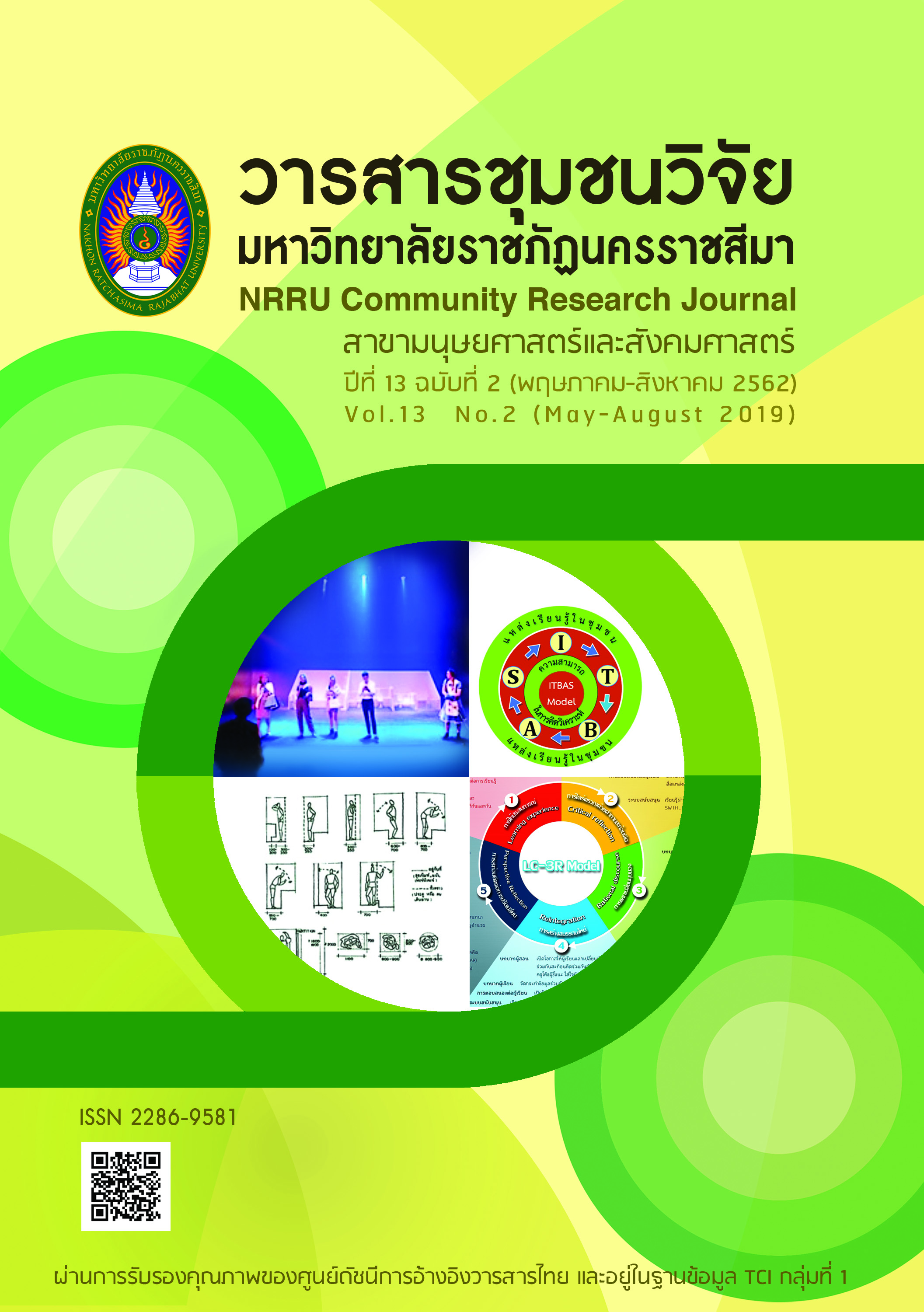ศักยภาพและปัญหาการท่องเที่ยวของจังหวัดกาญจนบุรีในฐานะเมืองชายแดน
DOI:
https://doi.org/10.14456/10.14456/nrru-rdi.2019.29คำสำคัญ:
ศักยภาพ, ปัญหาการท่องเที่ยว, การท่องเที่ยวชายแดนบทคัดย่อ
งานวิจัยมีวัตถุประสงค์เพื่อศึกษาศักยภาพและปัญหาการท่องเที่ยวของจังหวัดกาญจนบุรีในฐานะเมืองชายแดน เป็นงานวิจัยเชิงคุณภาพซึ่งประกอบด้วย 1) กระบวนการศึกษาและวิเคราะห์ข้อมูลจากเอกสาร หนังสือ ตำรา รายงาน แนวความคิด และบทความจากวารสารต่าง ๆ ข้อมูลจังหวัดกาญจนบุรี ที่เผยแพร่ระหว่างปี 2550-2559 จำนวน 124 เรื่อง และ 2) การจัดการสนทนากลุ่มผู้ทรงคุณวุฒิ จากหน่วยงานที่เกี่ยวข้องในจังหวัดกาญจนบุรี มี 4 กลุ่มประกอบด้วย ผู้ทรงคุณวุฒิภาครัฐ ผู้ทรงคุณวุฒิภาคการศึกษา ผู้ทรงคุณวุฒิภาคประชาสังคม และผู้ทรงคุณวุฒิภาคเอกชน กลุ่มละ 5 คน รวม 20 คน เครื่องมือที่ใช้ในงานวิจัยประกอบด้วยแบบบันทึกคุณลักษณะงานวิจัย และแบบสนทนากลุ่มของผู้ทรงคุณวุฒิ ทำการวิเคราะห์ข้อมูลด้วยวิธีวิเคราะห์เนื้อหา ผลการวิจัยพบว่า 1) มีศักยภาพด้านการท่องเที่ยวอยู่ในระดับสูง มีแหล่งท่องเที่ยวทางธรรมชาติและประวัติศาสตร์ที่น่าสนใจ มีวิถีชีวิตของชนเผ่าที่หลากหลาย โดยเฉพาะบริเวณแนวชายแดน การเปิดด่านชายแดนถาวรบ้านพุน้ำร้อน และการประกาศเขตเศรษฐกิจพิเศษชายแดน ความร่วมมือกันการเมืองระหว่างรัฐบาลไทยและรัฐบาลแห่งสหภาพพม่า เป็นองค์ประกอบสนับสนุนให้จังหวัดกาญจนบุรีมีโอกาสพัฒนาศักยภาพทางการท่องเที่ยวชายแดน 2) การวางแผนการพัฒนาการท่องเที่ยวชายแดน ยังไม่ได้ถูกบรรจุในแผนพัฒนาเขตเศรษฐกิจพิเศษชายแดน มีเหลื่อมล้ำของชุมชนที่เกิดจากการท่องเที่ยว มีปัจจัยภายนอกที่อยู่นอกเหนือการควบคุม ได้แก่ เสถียรภาพทางการเมืองภายในของประเทศเพื่อนบ้าน พื้นที่ชายแดนบางส่วนที่มีอาณาเขตติดต่อกับจังหวัดกาญจนบุรีอยู่ในความดูแลของชนกลุ่มน้อย ซึ่งมีบทบาทอย่างมากต่อการค้าและการท่องเที่ยวชายแดนอีกทั้งจังหวัดกาญจนบุรีตั้งอยู่ในพื้นที่เสี่ยงภัยแผ่นดินไหวเนื่องจากมีรอยเลื่อนศรีสวัสดิ์และรอยเลื่อนเจดีย์สามองค์ ผลการวิจัยได้ข้อมูลศักยภาพและปัญหาการท่องเที่ยวของจังหวัดกาญจนบุรีในฐานะเมืองชายแดน ข้อมูลที่ได้เป็นข้อมูลที่สำคัญในการประกอบ การตัดสินใจที่นำไปสู่ข้อเสนอแนะเชิงนโยบาย ซึ่งจะส่งผลต่อการพัฒนาการท่องเที่ยวของจังหวัดกาญจนบุรีในอนาคต
References
Bryman, A., & Burgess, R. G. (1994). Reflections on qualitative data analysis. Analyzing qualitative data, 216-226.
Buhalis, D. (2000). Marketing the competitive destination of the future. Tourism management, 21(1), 97-116.
Charumanee, N. (2001). Tourism and tourism industry management. (2nd ed.). Bangkok : Odeon Store Publishing. (In Thai)
Chatkul, N. (2014). Tourism Industry. Bangkok : Chulalongkorn University Press. (In Thai)
Cooper, C., Scott, N., & Baggio, R. (2009). Network position and perceptions of destination stakeholder importance. Anatolia, 20(1), 33-45.
Dickman, S. (1996). Tourism: An Introductory Text (2nded.). Sydney : Hodder Education.
Fainstein, S. S., & Judd, D. R. (1999). Global forces, local strategies, and urban tourism. The tourist city, 2.
Guba, E. G., & Lincoln, Y. S. (1982). Epistemological and methodological bases of naturalistic inquiry. ECTJ, 30(4), 233-252.
Hakim, C. (1987). Research Design: Succesful Designs for Social Economics Research. London : Routledge.
Immigration Bureau. (2017). Statistics of arrival - departure visitor of the Thai Kingdom classified by visa. Retrieved September 2017, from https://www.immigration.go.th/immigration_stats (In Thai)
International Institute for Trade and Development (Public Organization). (2015). Guidelines and measures for the development of special economic zones in the border areas of Thailand. Bangkok, Thailand : Author. (In Thai)
Jittangwattana, B. (2006). Sustainable tourism development. Bangkok: Press and Design. (In Thai)
Johnson, H., & Wilson, G. (2000). Biting the bullet: civil society, social learning and the transformation of local governance. World development, 28(11), 1891-1906.
Keogh, B. (1990). Public participation in community tourism planning. Annals of tourism research, 17(3), 449-465.
Matznetter, J. (1979). Border and tourism: Fundamental relations. In Paper presented at the Tourism and Borders: Proceedings of the Meeting of the IGU Working Group-Geography of Tourism and Recreation.-Frankfurt: Institut für Wirtschaftsund Sozialgeographie der Johann Wolfgang Goethe Universität (61-73).
Miles, M. B., Huberman, A. M., & Saldana, J. (2014). Qualitative data analysis 3rd Edition: Source book of Bew Methods. Baverly Hills: SAGE Publications Inc.
Ministry of the Interior. (2013). Announcement of the Ministry of Interior: Opening the Permanent Border Crossing BanPhunamron. The Government Gazette, 130(7), 9. (In Thai)
Moscardo, G. (2008). Community capacity building: An emerging challenge for tourism development. Building community capacity for tourism development, 1-15.
Office of Kanchanaburi Governor. (2017). Four years of Kanchanaburi Development Plan 2018-2021. Kanchanaburi, Thailand : Author. (In Thai)
Okech, R. N. (2010). Wildlife-community conflicts in conservation areas in Kenya. African journal on conflict resolution, 10(2), 68-80.
Parmar, B. L., Freeman, R. E., Harrison, J. S., Wicks, A. C., Purnell, L., & De Colle, S. (2010). Stakeholder theory: The state of the art. The academy of management annals, 4(1), 403-445.
Patton, M. Q. (1990). Qualitative evaluation and research methods: SAGE Publications, inc.
Pearce, P. L., Moscardo, G., & Ross, G. F. (1996). Tourism Community Relationships. Oxford : Pergamon Press.
Pelasol, M. R. J., Tayoba, M. A. T., Mondero, E., Jugado, K., & Lahaylahay, C. (2012). Igcabugao: a potential tourist destination in the southern part of Iloilo, Philippines. EDITORIAL BOARD, 71.
Phayakvichien, P. (2000). Sustainable tourism development. TAT Tourism Journal, 2(1), 5-10. (In Thai)
Pimolsompong, C. (2011). Plan and development of tourism marketing. Bangkok : Publisher of Kasetsart University,Thailand. (In Thai)
Reid, D. G., Mair, H., & Taylor, J. (2000). Community participation in rural tourism development. World Leisure Journal, 42(2), 20-27.
Swarbrooke, J. (1999). Sustainable tourism management. Cabi.
Timothy, D. J., & Tosun, C. (2003). Tourists’ perceptions of the Canada–USA border as a barrier to tourism at the International Peace Garden. Tourism management, 24(4), 411-421.
Woodhouse, A. (2006). Social capital and economic development in regional Australia: A case study. Journal of rural studies, 22(1), 83-94.



